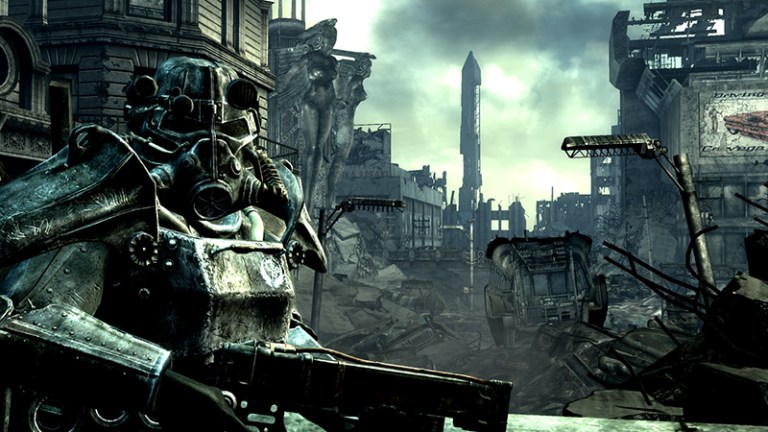How Bethesda Changed the Fallout Franchise
While Bethesda took the Fallout series to new heights, the franchise has undeniably changed under their leadership.

The fan-favorite post-apocalyptic video game series Fallout is the most prominent it has ever been, with an ambitious live-action television adaptation coming to Prime Video while publisher Bethesda SoftWorks continues to guide the games moving forward.
However, while Bethesda brought Fallout to new heights in 2008 with Fallout 3, the action RPG franchise goes back further by over a decade. Following Bethesda’s acquisition of the Fallout franchise, major changes were instituted that bristled purist fans of the initial games in the series for the alterations to gameplay and presentation.
Here is how Fallout began in 1997 before it was acquired by Bethesda in 2004 and eventually transformed into the gaming franchise millions of players know it as today.
The Origins of Fallout
The Fallout franchise was created by Tim Cain, a producer and programmer at Interplay Productions, with Cain initially starting development in relative isolation in 1994. A tabletop gaming enthusiast, Cain built Fallout around the Generic Universal Role-Playing System (GURPS), which many tabletop RPGs use for their own gameplay mechanics. Befitting the game’s roots in tabletop RPGs, the gameplay in Fallout is turn-based, rather than unfolding in real-time, and displayed from a trimetric perspective, rather than isometric or tracking the character from third or first-person.
Fallout was heavily inspired by the 1988 post-apocalyptic game Wasteland, which was developed by Interplay and published by Electronic Arts. When it became clear EA wasn’t interested in licensing out Wasteland, Interplay shifted their attention to a new IP. Cain’s game was originally titled Vault-13, referring to the fallout shelter where the player leaves at the beginning of the game to enter the wasteland of a bombed-out Southern California where the story is set. However, Interplay President Brian Fargo suggested the game’s final title of Fallout.
Looking back at Fallout now, nearly 30 years after its launch, it’s remarkable how much of that foundation remains intact, even with the change in developers and publishers and the general passage of time. Along with the overall premise of a vision of the United States centuries after enduring a devastating nuclear war, the darkly humorous tone and retro-futuristic design aesthetic remain intact. And though the gameplay mechanics have been revamped significantly, the idea of player abilities boosted by Perks and Action Points fueling special attacks, in addition to nonlinear progression and RPG elements, have been retained.
Simply put, Fallout, and its 1998 sequel Fallout 2, laid out a fantastic foundation and detailed sense of world-building that never needed much tampering with, even as gaming sensibilities have evolved. A lot of that foundational work comes from Cain, who resisted Interplay’s desire to make the game a real-time multiplayer after the success of 1997’s Diablo, and advocated for seeing the project through to completion while Interplay strongly contemplated canceling the project twice, once to prioritize development on its newly acquired properties, including Dungeons & Dragons, and again over the game’s nihilistic premise. That Fallout was created, let alone continues to survive and thrive, is something of a game industry miracle.
Fallout Changes Hands
By the late ‘90s into the early 2000s, Interplay’s financial outlook began to worsen considerably in the face of a changing gaming industry, leading them to close Fallout developer Black Isle Studios in 2003. To stave off insolvency, Interplay licensed out a number of its properties to outside publishers, with Fallout licensed to Bethesda SoftWorks in 2004. This licensing agreement allowed Bethesda to develop and publish three Fallout games while Interplay would retain full ownership of the franchise itself. Additionally, the licensing agreement allowed Interplay to develop and publish the planned Fallout Online, finally moving towards its long-standing hope to turn the property into an online multiplayer experience.
However, Interplay’s fortunes continued to worsen even after this licensing deal, causing the company to sell ownership of the Fallout property entirely to Bethesda in 2007 for $5.75 million. As part of this amended agreement, Interplay was still allowed to develop and publish Fallout Online, provided it could secure $30 million in funding within two years of the agreement, with the game launched within four years after officially beginning development. Arguing that Interplay hadn’t gained the necessary funding by 2009, Bethesda sued Interplay for breach of contract of the 2007 agreement, with the resulting settlement officially canceling Fallout Online and ceding the Fallout property’s ownership, including any plans for future online games, to Bethesda.
Fallout 3 Changes the Game
Production on Fallout 3 began in 2004 before ramping up in earnest after the completion of 2006’s The Elder Scrolls IV: Oblivion, with Fallout 3 using the same gameplay and graphics engine as Oblivion and retaining much of the fantasy game’s development team. Whereas previous games in the series took place on the American West Coast, Fallout 3 is set in Washington, D.C.: the planned setting for Interplay’s Fallout: Van Buren, which was canceled when Black Isle Studios was shuttered. However, Fallout 3 bears no resemblance to the shelved Van Buren, and its differences from past Fallout games are clear to the player right from the start.
Right off the bat, Fallout 3 is primarily displayed from a first-person perspective, though, like Oblivion before it, the player can switch to a third-person perspective if they so choose. Characters and environments are depicted with more realism, reflecting Oblivion‘s graphical basis. The gameplay unfolds largely in real-time and is the second game in the franchise to do so, after the 2004 top-down shooter spinoff Fallout: Brotherhood of Steel. Even with these changes and obvious similarities with Oblivion, Fallout 3, however, is still immediately recognizable as a Fallout game.
The overall aesthetic and tone of the preceding games are maintained in Fallout 3, as is the game’s nonlinear progression and Perk system. Though the combat unfolds in real-time, the idea of Action Points is reimagined through the V.A.T.S. (Vault-Assisted Targeting System), which significantly slows down time and allows players to pinpoint specific areas on targets and plan an order of attacks, consuming Action Points in the process. Unsurprisingly, the RPG elements were a bit closer to Oblivion than past Fallout games, though tweaked to match the overall sensibilities of Fallout.
For me, Fallout 3 always felt like a natural evolution for the franchise. Turn-based RPGs, no matter how much personality they had, had largely fallen out of fashion by 2008 (if not years earlier). The game has always felt, and continues to feel, like a modernized, and respectful relaunch of the franchise for wider audiences. As someone who played Oblivion extensively, Fallout 3 also felt incredibly intuitive and accessible. All three initial versions of the game – released on PC, Xbox 360, and PlayStation 3 – received strong reviews and were estimated to have sold a combined 12.4 million copies.
The reaction from the original games’ developers and their hardcore fans was more mixed, with franchise creator Tim Cain feeling like the player decisions didn’t have enough impact on the ending while appreciating the art design of the game. Fallout 2 writer Chris Avellone echoed Cain’s criticism, particularly with Fallout 3’s base game ending, but enjoyed the increased immersion due to the scope and change in perspective.
Fallout Reaches a Crossroads
Fresh off the enormous success of Fallout 3, Bethesda commissioned outside developer Obsidian Entertainment to develop that Bethesda would publish while its own development team focused on The Elder Scrolls V: Skyrim. Obsidian’s resulting game, 2010’s Fallout: New Vegas, was built upon the foundation laid by Fallout 3, with Obsidian also taking cues from the Interplay era Fallout games and Fallout 3 fan mods that had since surfaced online.
New Vegas refined the combat gameplay and streamlined the character customization compared to its predecessor, while adding more variety in weapons and Perks for the player. Notably, the spinoff also reincorporated the Reputation System, something introduced in Fallout 2, denoting how much loyalty or infamy players earned with the various warring factions present in the game. Owing to this back-to-the-basics approach was Obsidian hiring former Interplay Fallout developers Josh Sawyer and Chris Avellone to make New Vegas feel more like a bridge between the Interplay and Bethesda eras.
In the interim, Bethesda’s parent company, ZeniMax Media, acquired id Software, the pioneers of first-person shooting games with Wolfenstein 3D, Doom, and Quake. As Bethesda began development on Fallout 4, the combat mechanics were outsourced to id, who presented a more conventional first-person shooter approach to the gameplay, albeit while retaining and refining the V.A.T.S. mechanic from Fallout 3. Released in 2015, Fallout 4 added the ability to build and improve settlements, in a nod to the franchise’s community-building roots and, within the same launch window, outpaced Skyrim’s sales as the best-selling launch for a Bethesda title at that time.
It is here when the divide between classic Fallout players and the modern fans that started with Fallout 3 and its subsequent follow-ups became more acutely felt. Many were disappointed that Fallout 4 didn’t maintain the balance between gameplay mechanics and sensibilities showcased in New Vegas, with fans, even today, continuing to regard New Vegas as the pinnacle of the Bethesda era with the franchise to date. Fallout 4 doubled down on the direction Bethesda took with Fallout 3, and that continued drive without as much acknowledgment of its history marked a turning point for the series that divided the longtime fans and its new generation.
Fallout’s Continued Evolution
Over a decade after the initial plans to bring the world of Fallout to online multiplayer, Bethesda finally brought this vision to fruition with the release of Fallout 76 in 2018. With a lack of features and a boatload of technical bugs at launch, Fallout 76 was widely criticized by reviewers and fans alike. Performance issues aside, it felt like the franchise continued to stray away from its Interplay roots in terms of gameplay. Subsequent post-launch support has significantly improved Fallout 76’s quality, performance, and reception, but the gap between its classic era and its modern era is more noticeable than ever as Bethesda plans to create Fallout 5 after finishing a sixth mainline Elder Scrolls game.
Fallout today feels superficially like Fallout, but more like the iterations that have redefined the franchise since 2008, doubling down as an open-world first-person shooter with RPG flourishes rather than a more robustly designed RPG. Part of that is the passage of time, as the Interplay Fallout games move farther and farther into the rearview, relics of ‘90s PC gaming and providing players with a sci-fi alternative to Baldur’s Gate and Icewind Dale. For purists and gamers curious to see the series’ roots, the cool thing is that all those games are still available, through platforms like GOG, ready to revisit or experience for the first time.
For many, Fallout 3 and the rest of the Bethesda era of the franchise mark their gateway into the franchise, while the Interplay era are more from a simpler, bygone era of gaming. Like many gaming franchises, Fallout needed to evolve or risk falling into complete obscurity and irrelevance like so many of its contemporaries when it first launched. For all its alterations to the franchise, Bethesda made Fallout work for modern audiences while respecting the core of what made the property so beloved. Longtime players may not have pegged Fallout as a shooter series, but the DNA was always there, it just needed a fresh coat of paint to bring the franchise back from the dead.
The only question now, as Fallout faces an uncertain future is, whether it goes back-to-basics like New Vegas or furthering the direction Fallout 3 and its direct sequels have forged ahead with over the past decade.
